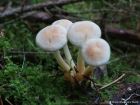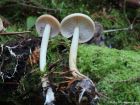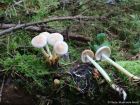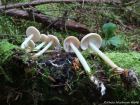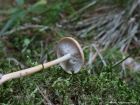Cap convex with an incurved margin when young, later broadly convex to plane, smooth and slightly viscid when fresh. It is reddish-brown to vinaceous-brown, hygrophanous, fading when dry to buff or pinkish-buff. Gills narrowly attached to the stem, sometimes appearing free, close and relatively broad, cream-buff to pale vinaceous-buff, often with shorter gills interspersed. Stem slender, cartilaginous and hollow, reddish-brown to purplish-brown, paler near the apex and covered with whitish hairs at the base. The stems are often fused together in dense clusters. No ring is present. Spore print white.
Microscopic Features: Spores are 5.5–7 x 2.5–3 µm, smooth, elliptical to nearly cylindric, inamyloid.
Synonyms: Collybia acervata and Gymnopus acervatus are older names for this species.
Connopus acervatus on the mykoweb.com web site.
Connopus acervatus on the MushroomExpert.Com web site.
Many mushrooms are poisonous, and some can be lethally toxic. Distinguishing between edible and poisonous mushrooms can be very challenging. Therefore, we strongly advise against consuming wild mushrooms. This website does not contain any information about the edibility or toxicity of mushrooms.
Although efforts have been made to ensure accuracy on this website, the information may contain errors and omissions. Therefore, all content provided is for educational and informational purposes only and should not be relied upon or used as a basis for consuming any plants or mushrooms.
External links are provided for reference only. We do not endorse or take responsibility for the content, advice, or products found on these sites or in any advertisements shown on this website.
